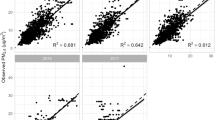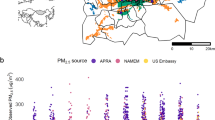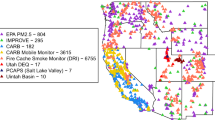Abstract
Background
The absence of air pollution monitoring networks makes it difficult to assess historical fine particulate matter (PM2.5) exposures for countries in the areas, such as Kuwait, which are severe impacted by desert dust and anthropogenic pollution.
Objective
We constructed an ensemble machine learning model to predict daily PM2.5 concentrations for regions lack of PM2.5 observations.
Methods
The model was constructed based on daily PM2.5, visibility, and other meteorological data collected at two sites in Kuwait. Then, our model was applied to predict the daily level of PM2.5 concentrations for eight airports located in Kuwait and Iraq from 2013 to 2020.
Results
As compared to traditional statistic models, the proposed machine learning methods improved the accuracy in using visibility to predict daily PM2.5 concentrations with a cross-validation R2 of 0.68. The predicted level of daily PM2.5 concentrations were consistent with previous measurements. The predicted average yearly PM2.5 concentration for the eight stations is 50.65 µg/m3. For all stations, the monthly average PM2.5 concentrations reached their maximum in July and their minimum in November.
Significance
These findings make it possible to retrospectively estimate daily PM2.5 exposures using the large-scale databases of historical visibility in regions with few particulate matter monitoring stations.
Impact statement
The scarcity of air pollution ground monitoring networks makes it difficult to assess historical fine particulate matter exposures for countries in arid areas such as Kuwait. Visibility is closely related to atmospheric particulate matter concentrations and historical airport visibility records are commonly available in most countries. Our model make it possible to retrospectively estimate daily PM2.5 exposures using the large-scale databases of historical visibility in arid regions with few particulate matter ground monitoring stations. The product of such models can be critical for environmental risk assessments and population health studies.
This is a preview of subscription content, access via your institution
Access options
Subscribe to this journal
Receive 6 print issues and online access
$259.00 per year
only $43.17 per issue
Buy this article
- Purchase on Springer Link
- Instant access to full article PDF
Prices may be subject to local taxes which are calculated during checkout







Similar content being viewed by others
Data availability
All data included in this study are available upon request by contact with the corresponding author.
References
Al-Hemoud A, Al-Dousari A, Al-Dashti H, Petrov P, Al-Saleh A, Al-Khafaji S et al., Sand and dust storm trajectories from Iraq Mesopotamian flood plain to Kuwait. Sci Total Environ. 2019;710:136291.
Li J, Garshick E, Al-Hemoud A, Huang S, Koutrakis P. Impacts of meteorology and vegetation on surface dust concentrations in Middle Eastern countries. Sci Total Environ. 2020;712:136597.
Zanobetti A, Schwartz J. The effect of fine and coarse particulate air pollution on mortality: a national analysis. Environ Health Perspect. 2009;117:898–903.
Crouse DL, Peters PA, Hystad P, Brook JR, van Donkelaar A, Martin RV, et al. Ambient PM2.5, O(3), and NO(2) exposures and associations with mortality over 16 years of follow-up in the canadian census health and environment cohort (CanCHEC). Environ Health Perspect. 2015;123:1180–6.
Di Q, Wang Y, Zanobetti A, Wang Y, Koutrakis P, Choirat C, et al. Air pollution and mortality in the medicare population. N Engl J Med. 2017;376:2513–22.
Huang S, Xiong J, Vieira CLZ, Blomberg AJ, Gold DR, Coull BA, et al. Short-term exposure to ambient particle gamma radioactivity is associated with increased risk for all-cause non-accidental and cardiovascular mortality. Sci Total Environ. 2020;721:137793.
van Wijngaarden E, Rich DQ, Zhang W, Thurston SW, Lin S, Croft DP, et al. Neurodegenerative hospital admissions and long-term exposure to ambient fine particle air pollution. Ann Epidemiol. 2021;54:79–86.
Li J, Wang Y, Steenland K, Liu P, van Donkelaar A, Martin RV et al., Long-term effects of PM2.5 components on incident dementia in the northeastern United States. The Innovation. 2022;3:100208.
Brown KW, Bouhamra W, Lamoureux DP, Evans JS, Koutrakis P. Characterization of particulate matter for three sites in Kuwait. J Air Waste Manag. 2008;58:994–1003.
Engelbrecht JP, McDonald EV, Gillies JA, Jayanty RKM, Casuccio G, Gertler AW. Characterizing mineral dusts and other aerosols from the Middle East—Part 1: ambient sampling. Inhal Toxicol. 2009;21:297–326.
NationalResearchCouncil, Review of the Department of Defense enhanced particulate matter surveillance program report. Appendix D - Final report of the Department of Defense enhanced particulate matter surveillance program. National Academies Press: Washington, DC, 2010.
Alolayan MA, Brown KW, Evans JS, Bouhamra WS, Koutrakis P. Source apportionment of fine particles in Kuwait City. Sci Total Environ. 2013;448:14–25.
Al-Hemoud A, Al-Dousari A, Al-Shatti A, Al-Khayat A, Behbehani W, Malak M. Health Impact assessment associated with exposure to PM10 and dust storms in Kuwait. Atmosphere 2018;9:6.
Al-Hemoud A, Gasana J, Al-Dabbous A, Alajeel A, Al-Shatti A, Behbehani W, et al. Exposure levels of air pollution (PM2.5) and associated health risk in Kuwait. Environ Res. 2019;179:108730.
Abbey DE, Ostro BE, Fraser G, Vancuren T, Burchette RJ. Estimating fine particulates less-than 2.5 microns in aerodynamic diameter (PM 2.5) from airport visibility data in California. J Expo Anal Env Epid. 1995;5:161–80.
Vajanapoom N, Shy CM, Neas LM, Loomis D. Estimation of particulate matter from visibility in Bangkok. Thail J Expo Anal Env Epid. 2001;11:97–102.
Zhao T, Yang L, Yan W, Zhang J, Lu W, Yang Y, et al. Chemical characteristics of PM1/PM2.5 and influence on visual range at the summit of Mount Tai, North China. Sci Total Environ. 2017;575:458–66.
Liu M, Bi J, Ma Z. Visibility-based PM2.5 concentrations in China: 1957-64 and 1973-2014. Environ Sci Technol. 2017;51:13161–9.
Masri S, Garshick E, Hart J, Bouhamra W, Koutrakis P. Use of visual range measurements to predict fine particulate matter exposures in Southwest Asia and Afghanistan. J Air Waste Manag Assoc. 2017;67:75–85.
Li J, Garshick E, Hart JE, Li L, Shi L, Al-Hemoud A, et al. Estimation of ambient PM2.5 in Iraq and Kuwait from 2001 to 2018 using machine learning and remote sensing. Environ Int. 2021;151:106445.
Zhao G, Hu M, Zhang Z, Tang L, Shang D, Ren J et al., Current challenges in visibility improvement in Sichuan basin. Geophys Res Lett. 2022;49:1–7.
Masri S, Garshick E, Coull BA, Koutrakis P. A novel calibration approach using satellite and visibility observations to estimate fine particulate matter exposures in Southwest Asia and Afghanistan. J Air Waste Manag Assoc. 2017;67:86–95.
Alahmad B, Al-Hemoud A, Kang CM, Almarri F, Kommula V, Wolfson JM, et al. A two-year assessment of particulate air pollution and sources in Kuwait. Environ Pollut. 2021;282:117016.
Di Q, Kloog I, Koutrakis P, Lyapustin A, Wang Y, Schwartz J. Assessing PM2.5 exposures with high spatiotemporal resolution across the continental United States. Environ Sci Technol. 2016;50:4712–21.
Joharestani MZ, Cao C, Ni X, Bashir B, Talebiesfandarani SJA. PM2.5 prediction based on random forest, XGBoost, and deep learning using multisource remote sensing data. 2019;10:373.
Bishop CM. Pattern Recognition and Machine Learning. Springer 2006, 1.
Requia WJ, Di Q, Silvern R, Kelly JT, Koutrakis P, Mickley LJ, et al. An ensemble learning approach for estimating high spatiotemporal resolution of ground-level ozone in the contiguous United States. Environ Sci Technol. 2020;54:11037–47.
WHO, WHO Global Air Quality Guidelines: Particulate Matter PM2.5 and PM10), Ozone, Nitrogen Dioxide, Sulfur Dioxide and Carbon Monoxide. 2021.
Acknowledgements
This work was supported by the VA Cooperative Studies Program #595: Pulmonary Health and Deployment to Southwest Asia and Afghanistan, from the United States (U.S.) Department of Veterans Affairs, Office of Research and Development, Clinical Science Research and Development, Cooperative Studies Program. This publication was also made possible by U.S. Environmental Protection Agency (EPA) grant RD-835872 and NASA grant 80NSSC19K0225. The contents do not represent the views of the U.S. Department of Veterans Affairs, U.S. EPA, or the U.S. Government.
Author information
Authors and Affiliations
Contributions
PK and EG designed the research and directed its implementation; CK, JW, and AA prepared the data; JL analyzed the data and prepared the manuscript; all authors contributed to data interpretation and revisions of the manuscript.
Corresponding author
Ethics declarations
Competing interests
The authors declare no competing interests.
Additional information
Publisher’s note Springer Nature remains neutral with regard to jurisdictional claims in published maps and institutional affiliations.
Supplementary information
Rights and permissions
Springer Nature or its licensor holds exclusive rights to this article under a publishing agreement with the author(s) or other rightsholder(s); author self-archiving of the accepted manuscript version of this article is solely governed by the terms of such publishing agreement and applicable law.
About this article
Cite this article
Li, J., Kang, CM., Wolfson, J.M. et al. Estimation of fine particulate matter in an arid area from visibility based on machine learning. J Expo Sci Environ Epidemiol 32, 926–931 (2022). https://doi.org/10.1038/s41370-022-00480-3
Received:
Revised:
Accepted:
Published:
Issue Date:
DOI: https://doi.org/10.1038/s41370-022-00480-3
Keywords
This article is cited by
-
Burden of fine air pollution on mortality in the desert climate of Kuwait
Journal of Exposure Science & Environmental Epidemiology (2023)
-
Exposure forecasting – ExpoCast – for data-poor chemicals in commerce and the environment
Journal of Exposure Science & Environmental Epidemiology (2022)



